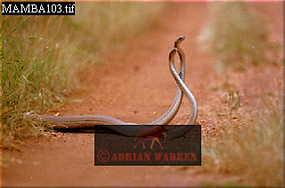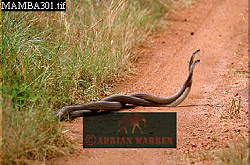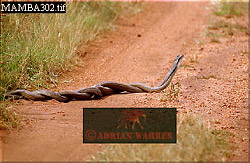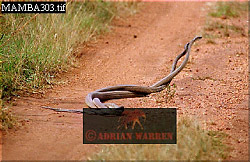(INTRODUCTION: Adrian Warren describes a memorable close encounter with black mambas in Akagera National Park, Rwanda. After first visiting Akagera in 1987 while filming for the BBC series "The Great Rift", it became a favourite haunt while based in Rwanda working on two subsequent film projects on Mountain Gorillas in the Virunga Volcanoes. )
It was one of those pearly grey African dawns, the sky was slightly overcast and a heavy dew had settled. Further down the valley hippos were sloshing about along the edge of a shallow lake, and a dove was calling, a song that I always connect with Africa. A pride of lions had been close-by for most of the night but now they were quiet, and the impala, moving with dainty elegance down the slope to my left, were calm. It was cool, the sun would not be up for another ten minutes or so, everything poised in anticipation for that transition from night to day. I was sitting in front of a simple house of whitewashed mud bricks, occupied by a Belgian zoologist who was studying roan and eland, as well as being part of a team working on a management plan for the Akagera Park. It's 965 square miles, plus an additional 123 square miles of Mutara game reserve, in the north-eastern corner of Rwanda in Central Mrica, account for some ten per cent of the total surface area of the country. Although a small park by African standards, it is surprisingly large for a tiny country like Rwanda, straining at the seams with people desperate for a tiny fragment of land to grow something to eat.
Stanley came here in 1876 on one of his journeys seeking for the truth about the source of the Nile. He had come up the Akagera river and had climbed a hill to take in the view of the broad valley of the Akagera, which he called the Alexandra Nile, filled with lakes and papyrus swamps. Beyond the valley he could see " ridge after ridge, separated from each other by deep parallel basins, or valleys, and behind these, receding into dim and vague outlines, towered loftier ridges. About sixty miles off, to the north-west, rose a colossal Sugar-loaf clump of enormous altitude, which I was told was the U{llmbiro mountains." The distant peaks were actually the Virunga Volcanoes, home of Mountain Gorillas which would remain unseen by Europeans until 1902. The broad valley with its lakes and papyrus swamps are home for sitatunga (aquatic antelopes) and the rare shoebill stork. In 1987 we discovered lions on the floating islands of papyrus where they preyed on the sitatunga, presumably swimming from island to island where walking is a wet experience and rather like moving around on a giant water bed.
The Akagera landscape is rich and varied, the steep hills with their neat parallel ridges form an almost complete savannah ecosystem intersected by strips of forest; huge areas to wander in for days without seeing another human being -so different to the traffic jams of the Kenyan Parks. Akagera was the site for successful re-introductions of giraffe and elephant, and there was an ambitious plan to do the same for wild dogs but momentum for that project died with the war in Rwanda that sadly resulted in mines being senselessly laid in the Park and countless animals being shot to feed soldiers.
As I sat, watching the dawn, Akagera was still peaceful; the war was still two years away. I felt uncomfortable but only because I had to leave this place. The sun was now up, drying off the dew and bringing the first tsetse flies. Reluctantly, I packed the landcruiser and joined the dirt road that leads from Shama to Gabiro at the entrance to the Park some forty minutes drive distant. By my side were binoculars and camera in case we encountered something interesting. The road slowly wound its way along the foot of a line of hills; past the turning where we had looked for the female black rhino and her calf; past the place where we could always count on seeing a large herd of buffalo; and I was beginning to think that the journey would be uneventful until, on rounding a comer we encountered two large snakes, at the edge of the dirt road coiled around each other in a vigorous dance that I immediately thought was a courtship activity. It did not take long to realize that we were looking at two large black mambas. It took about half a minute to weigh up the situation through binoculars; black mambas are extremely dangerous, known to pursue victims at high speed, but these two seemed so preoccupied with each other, I decided to slowly and carefully open the door and crawled in front of the car, ending up sitting on the ground with my back resting against the front fender less than ten metres away from- the snakes. Remarkably, the mambas continued their dance, ignoring me and the car. With the 300mm lens resting on my knees I had a wonderful view of their behaviour, which continued for at least five minutes before they moved into the long grass at the edge of the road, out of view. I decided not to pursue them.
I was wrong in thinking that the mambas were engaged in courtship. There is little doubt that the two mambas were to adult males in combat, a wrestling match that ends up in one of them being exhausted, and fleeing. It is probable that a female was nearby and the males were fighting for the right to mate with her. Harry Green, from the University of California at Berkeley, writes that "male-male combat is recorded for mambas as well as various vipers, colubrids and other elapids. Mating is typically a quieter affair, without the extensive intertwining or the upraised foreparts."
It was one of those incredibly lucky encounters, completely unpredictable and one that will never be forgotten. It lifted the bleak mood of departure as we continued on down the road that led us out of the Park at Gabiro.




